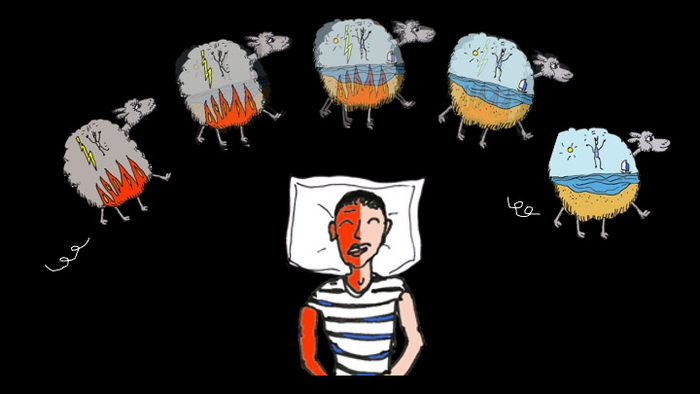Oppressive, frightening, nerve-wracking: nightmares are particularly disturbing dreams. They are considered pathological when they occur frequently (>1 episode per week) and cause daytime fatigue, mood alteration and anxiety. Although Imagery Rehearsal Therapy (IRT) has shown some effectiveness, some patients do not respond to this treatment. A team from the UNIGE and the HUG has developed a promising new technique combining this classic therapy with the Targeted Memory Reactivation (TMR) method. Thanks to this new therapy, the patients’nightmares decreased significantly and their positive dreams increased. These results can be found in the journal Current Biology.

Credit: © Sophie Schwartz
Oppressive, frightening, nerve-wracking: nightmares are particularly disturbing dreams. They are considered pathological when they occur frequently (>1 episode per week) and cause daytime fatigue, mood alteration and anxiety. Although Imagery Rehearsal Therapy (IRT) has shown some effectiveness, some patients do not respond to this treatment. A team from the UNIGE and the HUG has developed a promising new technique combining this classic therapy with the Targeted Memory Reactivation (TMR) method. Thanks to this new therapy, the patients’nightmares decreased significantly and their positive dreams increased. These results can be found in the journal Current Biology.
Nightmares are dreams with strong negative emotions that occur during rapid eye movement (REM) sleep. Clinicians distinguish them from simple ‘‘bad dreams’’. In contrast to nightmares, the latter seem to have a useful function in promoting the regulation of emotions. Scientists also make a distinction between traumatic nightmares – i.e. linked to a state of post-traumatic stress – and nightmares without traumatic origin.
According to the ‘‘International Classification of Sleep Disorders’’, established by the American Academy of Sleep Medicine, nightmares become pathological when they are recurrent and have an impact during the day causing, for example, fatigue, anxiety, dysphoria or intrusive nightmare imagery. This is known as ‘‘nightmare disorder’’ and is an increasingly common reason for medical consultation.
Treating nightmares
Imagery Rehearsal Therapy (IRT) is frequently used to treat this disorder. This cognitive technique requires that the patients imagine alternative and positive outcomes to their nightmare scenarios every day for five to ten minutes. ‘‘After two weeks of practice, it has been shown that the frequency of nightmares decreases,’’ says Lampros Perogamvros, a privat-docent in the Department of Basic Neurosciences at the UNIGE Faculty of Medicine and a senior clinical fellow at the HUG’s Center for Sleep Medicine.
However, some patients are not receptive to this method. To overcome this limitation and boost the treatment process, Dr Lampros Perogamvros and his colleagues have coupled IRT with the Targeted Memory Reactivation (TMR) method. By sending specific stimuli to the brain of the sleeping person – often odours or sounds previously associated with recent experiences – it is possible to reinforce the memory of this experience. In this case, the aim was to reactivate memories related to the IRT exercises.
A piano chord played every ten seconds
The team from the UNIGE and the HUG gathered 36 patients suffering from the non-traumatic type of nightmares. Two groups were formed: one to practice the coupled therapy, the other the classical therapy with IRT only. ‘‘We asked the patients to imagine positive alternative scenarios to their nightmares. However, one of the two groups of patients did this exercise while a sound – a major piano chord – was played every ten seconds. The aim was for this sound to be associated with the imagined positive scenario. In this way, when the sound was then played again but now during sleep, it was more likely to reactivate a positive memory in dreams,’’ explains Sophie Schwartz, a full professor in the Department of Basic Neurosciences at the UNIGE Faculty of Medicine and the Swiss Center for Affective Sciences.
Each participant was then given a sleep headband containing electrodes that measure brain activity. At home, thanks to this device detecting the different stages of sleep, the piano chord was replayed every ten seconds each time the patient reached REM sleep. The exercise was repeated every night for two weeks.
More efficient and more lasting impact
At the end of the experiment, the frequency of nightmares decreased in both groups, but significantly more in the group where the positive scenario was associated with the sound. ‘‘Moreover, this association resulted in an increase in positive dreams,’’ says Alice Clerget, a master’s student in the Department of Basic Neuroscience at the Faculty of Medicine, who actively participated in the study. Finally, the benefits of the coupled treatment were still perceptible three months after the experiment, with patients in the TMR group still having fewer nightmares than those in the group without TMR.
‘‘While the results of the therapy coupling will need to be replicated before this method can be widely applied, there is every indication that it is a particularly effective new treatment for the nightmare disorder. The next step for us will be to test this method on nightmares linked to post-traumatic stress,’’ concludes Lampros Perogamvros. These results also open up new perspectives for the treatment of other disorders such as insomnia and other symptoms of post-traumatic stress, such as flashbacks and anxiety.
Journal
Current Biology
DOI
10.1016/j.cub.2022.09.032
Method of Research
News article
Article Title
Enhancing imagery rehearsal therapy for nightmares with targeted memory reactivation
Article Publication Date
27-Oct-2022




